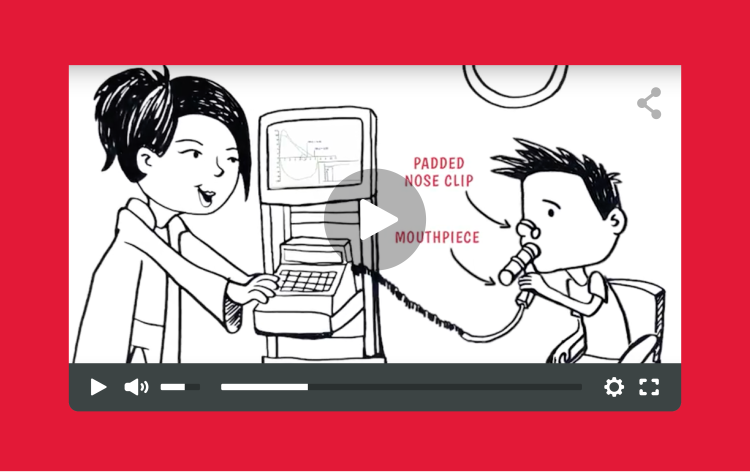
Pulmonary management in Duchenne (all of the care involved with breathing and coughing) can be confusing and difficult to understand. There are many terms, abbreviations, and procedures that all sound very complicated. PPMD – with support from Santhera Pharmaceuticals and input from a panel of parents, patients, and pulmonologists – has created a series of five short, informative animated videos to clarify, simplify, and teach important topics concerning pulmonary care. We also ask that you take a Breathing/Respiratory module (found at the end of this blog) and share your pulmonary journey.
Before you explore the new videos, check out this introductory webinar by Dr. Jonathan Finder, Children’s Hospital Pittsburgh. In this webinar, Dr. Finder discusses the importance of pulmonary care, the meaning of the abbreviations used by your pulmonary team, and procedures and tests that your pulmonary team might use to monitor cough and breathing. It’s a great complementary piece to help you better grasp the detailed information in these videos.
The series of five videos cover:
Video 1: What to Expect at Your Pulmonary Visit
If you have never been seen by a pulmonologist, you may not know what to expect during your visit. This video explains what will happen during your visit and what to expect.
Video 2: Cough
Coughing is how you clear your lungs and airway, keeping germs and other toxins out of your respiratory tract. This video explains all that is involved when your body coughs, and why coughing is important.
Video 3: Assisted Cough
Over time, the muscles that help you cough may become too weak to cough effectively. Mucous containing germs and other toxins can remain in your lungs, causing you to get sick more easily. If you cough becomes too weak to remove this mucous from your lungs and airways, you will need some help coughing. This video explains the different ways that your cough can be assisted, keeping your airways clean and your lungs health.
Video 4: Nighttime Breathing
Monitoring your breathing during sleep is important. While you sleep, your body breathes oxygen in and carbon dioxide out. If your body is not getting enough oxygen, or has too much carbon dioxide, you won’t feel your best while you are awake.
Video 5: C-PAP/BiPAP
The differences between C-PAP (continuous airway pressure) and Bi-PAP (bi-level airway pressure), two methods of assisting nighttime breathing, can be confusing. This video explains the difference between the two and when each should be considered/used.
We hope you find these videos helpful!
Share Your Data
Your pulmonary journey can help tell the story of pulmonary health in Duchenne and increase the understanding of experts in the field. That’s why we are asking you to update your Breathing/Respiratory module in the DuchenneConnect Registry. Log into your DuchenneConnect account, go to your profile page, and click on the Breathing/Respiratory module link. Either complete the survey for the first time, or select “Retake this survey” if you are updating your information.
Not in the Registry? Join today and become a Citizen Scientist, adding your data to the already powerful DuchenneConnect Registry! Please take 10 minutes today to complete this survey and you could win a prize this month, including a new iPad!



 by: Parent Project Muscular Dystrophy
by: Parent Project Muscular Dystrophy

